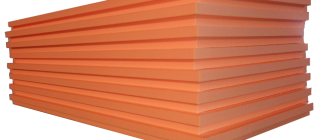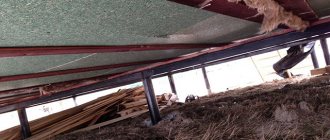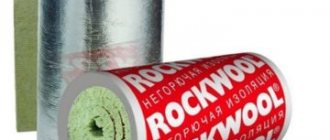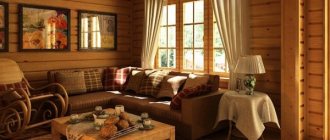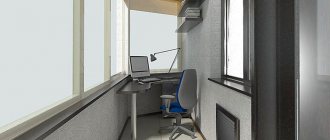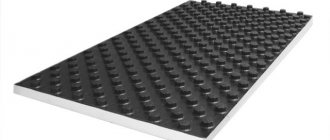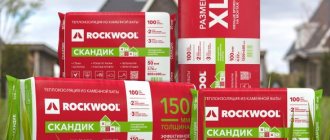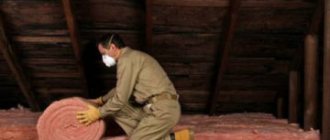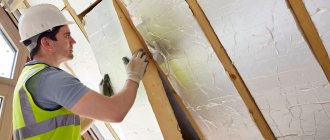The technology of insulating the floor on a balcony is a process in the implementation of which it is important not to make mistakes. At the stage of repairing a balcony room, it is imperative to correctly resolve the issue of thermal insulation. This determines whether mold will appear and whether condensation will accumulate on surfaces during the cold season. In today’s article we will consider every aspect of organizing insulation, and will also tell you which materials to choose for this purpose and, accordingly, how to work with them.
Insulation of the floor on the balcony between the boards Source build-experts.ru
Foamed polyethylene
This is one of the most affordable and easy-to-use materials. Its distinctive feature is its small thickness; therefore, it is not recommended to use it for insulation without an additional insulator. This is due to the fact that the coating will not perform its function properly.
Thermal insulation layer with polyethylene foam on the balcony Source samsebemaster.net
An alternative to simple foam insulation is foil foam. Such sheets cope quite well with thermal insulation properties. Even despite the presence of a reflective layer, this insulation is well ventilated, so the accumulation of condensation in it is minimized. Foil polyethylene can have a mirror coating on one or both sides. The latter will be more effective and more expensive.
It is important to install such material correctly, since the insulation must be overlapped or end-to-end. Foamed polyethylene is laid with the reflective surface facing up.
Foamed foil polyethylene is placed both on the floor and on the walls Source oknosnz.ru
Expanded polystyrene
Expanded polystyrene or polystyrene foam for insulating the floor on the balcony is available in the form of slabs of different thicknesses. They are convenient to lay on a concrete base. As for the important properties, the material is poorly thermally conductive, has low weight, and as a result, can be installed without much effort. The foam is also moisture resistant. It should also be noted that it is vapor tight.
One of the disadvantages of this is its fragility, so work on laying it on the floor must be carried out carefully.
Expanded polystyrene sheets for insulating the concrete base on the balcony Source russian.alibaba.com
Foam plastic (expanded polystyrene)
The most common sheet material for insulating balconies. Its composition is a frozen foam, the closed pores of which contain air. 5 cm thick is usually used ; for harsher climates, it is recommended to choose thicker sheets up to 10 cm .
The material has a number of advantages that determined its popularity:
- low thermal conductivity coefficient, which ensures high thermal insulation of the room even without the use of other materials;
- high water absorption rate, which makes it possible not to lay an additional layer of waterproofing;
- sufficient strength makes it possible to use dense and heavy finishing materials;
- environmental friendliness - no dust is generated during operation, no harmful substances are released during further operation;
- hygiene – mold and mildew cannot form in polystyrene foam;
- ease of use and ease of installation - the sheet can be cut into parts of any size;
- low cost compared to other insulation materials;
- service life up to 30 years, subject to compliance with installation technology.
The main disadvantages of polystyrene foam:
- low air permeability – when insulating a loggia with this material, it is necessary to provide additional methods of ventilation, otherwise it will not be possible to ensure a comfortable microclimate in the room;
- poor sound insulation properties;
- insufficient resistance to certain types of drying oils, varnishes and other chemicals based on petroleum products and alcohols - this requires special care when choosing finishing materials;
- high flammability and, accordingly, fire hazard.
To insulate a balcony, you must choose construction foam made by extrusion with a density of 35-40 kg/m3 . Types with an indicator of less than 25 kg/m3 are packaging materials and are not suitable for construction work. To determine the quality of the material, break off a piece from the sheet and look at the structure. Construction foam has cells in the form of polygons, packaging foam consists of easily detachable balls.
Preparing for floor insulation
Having decided on the type of alternative insulation, you can begin its installation, but first we recommend that you carefully study this section dedicated to preparatory work. It will consist of several step-by-step actions:
- A general assessment of the condition of the floor is carried out; if there are visible defects on the surface, they are removed by concreting; large potholes are eliminated using rubble and concrete screed.
- If there are old tiles on the floor, it is not necessary to remove them, unless the factor that the height of the floor will rise by several centimeters plays a role.
- Fill small cracks. It is a mistake to believe that nothing will happen to them under a layer of insulation. Such defects will begin to quickly deteriorate, and moisture will certainly settle in them. If a crack appears on the old tile masonry, then it is dismantled, and then a smooth concrete screed is poured into the old place.
- After removing all defects, clean the surface from dust and then prime it. Then the areas that were defective are treated with a sealant.
- The next stage is waterproofing. After laying the rolled sheet or tile, check each joint for gaps. Only then is a thermal insulation layer applied.
Preparing the floor on the balcony for thermal insulation Source obustroeno.club
Carrying out preparatory work
Before insulating the balcony, it is necessary to carry out preparatory work. If you do not prepare the working surface, the tenant will receive poor-quality insulation that will not last even 5 years.
Progress:
- Clean the balcony area with a spatula or something similar from plaster and paint.
- Degrease the surface.
- The windows should already be installed.
- Cover the windows and doors of the balcony with film.
- Route the wiring through the corrugation.
- Install the sheathing.
Methods for laying insulation on the floor
To lay the insulation layer on a small balcony floor, two methods can be used. About them below:
- on wooden racks (logs). The construction of such a structure is necessary to pre-level the coating before further laying. The logs are raised to a height equal to the thickness of the insulation layer. The structure can be supported on metal corners or special brackets;
- insulation of the floor using the heating function. Its role will be played by a heating cable or infrared film. It can also be a water structure, which is connected to stationary heating.
Knocking off beacons for installing logs on the balcony under insulation Source transkribator.guru
Below in this section we will talk about methods for arranging each of these two options.
Materials and tools
Before starting work, you need to buy basic and auxiliary materials and prepare a set of tools. Materials you will need:
- insulation (its quantity is equal to the insulated area);
- Chipboard, plywood or OSB (chipboard is better, since it only exhibits linear expansion during fluctuations in humidity and temperature);
- waterproofing material (the specific choice of waterproofing agents will be discussed in a separate work);
- vapor barrier film (needed when using soft insulation);
- primer;
- wooden beam (specific dimensions depend on the thickness of the insulation);
- metal U-shaped supports for attaching timber or studs;
- polyurethane foam;
- self-tapping dowels for fixing supports to the base of the balcony;
- electrical tape (painting tape) for gluing insulation joints;
- wood screws for connecting the timber to the supports.
Attention: the tiles are laid on a screed, which requires completely different materials and tools, which you can read about in the material “Technology of wet floor screed with expanded clay.”
The tools you need to have on hand are:
- electric drill or powerful screwdriver;
- hammer drill (needed only for leveling the base of the balcony and removing the plaster layer from the bottom of the walls to the thickness of the thermal insulation);
- jigsaw or wood saw;
- construction knife with replaceable blade;
- roulette;
- construction pencil.
Video description
Do-it-yourself insulation of the floor on the loggia.
How to make thermal insulation on joists
Thermal insulation on joists requires not only the insulation material itself, but also wooden beams and a metal profile. The entire insulation process in this way is carried out according to the following algorithm:
- Cleaning the base and making it functional (filling holes and leveling the concrete screed.
- Marking the surface for the racks. Marks are placed every 50 cm, at these points the longitudinal joists will be attached.
- Installation of racks for each jumper. To do this, a mark is made every five centimeters, starting from the wall.
- Finding the zero line on the wall. Here they use a laser or a water level. This parallel is used to level the height of each joist.
- They install racks or brackets that are securely fastened to the concrete base, put the logs in place, and correct them.
- Insulation is laid between the installed beams, rolls or slabs are cut so that a small margin remains. This is necessary for compaction, which will help hide all voids in the structure.
- A diffuse membrane is laid on top, which will provide vapor and waterproofing, then sheets of plywood are laid and secured to the joists.
- At the end, they make sure that there is a correct slope (or lack thereof), and then they make the finishing touch - laying the floor covering.
When laying the thermal insulation layer, you need to ensure that there are no gaps or holes. Otherwise, the insulator will not fulfill its direct tasks.
The principle of thermal insulation under logs Source eco-kotly.ru
How to install insulation in combination with underfloor heating
It is often practiced to combine insulation with electric or other type of heating. The effect of this is much higher, but it is also more difficult to install in this way. The whole process is based on the following steps:
- First of all, the floor on the balcony is insulated according to the scheme described in the previous paragraph.
- Next, lay the foil backing so that the reflective layer is on top. If the fragments are not solid, then they are laid strictly at the joint and secured with adhesive tape with a reflector.
- The film heater or underfloor heating pipes are laid out along the length of the floor. Each element is monitored so that there are no kinks and the heater sheets do not overlap each other.
- If the heaters are electric, then they are covered with thick plastic film so that they do not come into contact with moisture.
- The final step is to apply the finishing trim.
Installation of the insulating coating can be done by hand. The main thing is to follow the steps so as not to miss laying this or that material.
Installation of thermal insulation and heated floors on the balcony Source drive2.ru
Insulation for a balcony: choosing the best option, installation tips
A good owner will definitely try to turn the balcony in his apartment into the most functional room possible. It is clear that since the balcony is in direct contact with the street, the main problem, in addition to glazing, is its thermal insulation. If we take this issue seriously, then planning such events should begin with studying the characteristics, and then the correct choice of insulation materials.
Insulation for balconies
When choosing insulation for a balcony, you must first take into account the average winter temperature of your region of residence. But, besides this, before purchasing, be sure to compare several different options, comparing their operational capabilities and the degree of safety for humans.
The proposed table presents the main characteristics of most building and insulating materials that can be used to convert a balcony into additional usable area of the apartment.
| Materials | Thermal conductivity coefficient, W/m×°С | Density, kg/m³. | Operating temperature range, °C | Vapor permeability, mg/(m×h×Pa) |
| Polyurethane foam | 0,025 | 40-60 | -100 to +150 | 0,04-0,05 |
| Extruded polystyrene foam | 0,05 | 30-45 | From - 50 to +75 | 0,015 |
| Polyethylene foam | 0,045 | 35 | -60 to +90 | 0,001 |
| Styrofoam | 0,03 | 40-125 | -50 to +75 | 0,23 |
| Stone wool | 0,047 | 35-150 | -60 to +180 | 0,53 |
| Glass wool | 0,056 | 15-100 | -60 to +480 | 0,53 |
| Reinforced concrete | 2,04 | 2500 | 0,03 | |
| Hollow brick | 0,58 | 1400 | 0,16 | |
| Wood (across the grain) | 0,18 | 40-50 | 0,06 |
“Dry” numbers can already say a lot, but it is still necessary to take a closer look at the most commonly used insulation materials. To begin with, it will be useful to understand the criteria that thermal insulation material for a balcony must meet.
Criteria for choosing insulation
Since a completely unheated room that does not have thick walls will be insulated, the following qualities of the thermal insulation material must be provided:
- It should have low thermal conductivity - this will help retain the heat coming to the balcony from heated rooms or from heating devices, preventing it from quickly leaving the room.
Naturally, the lower the thermal conductivity index, the more effective the thermal insulation.
- The thermal conductivity indicator directly depends on the density - if it is high, then one can only dream of good thermal insulation performance. If the insulation has a porous structure, then low thermal conductivity will be ensured.
- It is necessary to choose insulation with low vapor permeability or, in other words, a predisposition to hygroscopicity, since any material saturated with moisture loses its thermal insulating qualities.
- The insulation must be non-flammable or at least self-extinguishing. On the packaging, the flammability of the insulation is marked with the designations G1 to G4. The number “1” means minimal, and “4” means high flammability of the material.
In addition, it is important to pay attention to the smoke production of burning insulation. This indicator is marked with designations from D1 to D3.
Another important fire safety parameter is the rate of spread of the flame. On the packaging of the insulation, this characteristic can be indicated by letters and numbers, from RP1 to RP4. RP1 means that the material will not become a fire carrier, and RP4 indicates the rapid spread of flame after ignition.
A material correctly selected according to these criteria will probably save the life and health of apartment residents if a fire suddenly occurs.
- The environmental friendliness of the material is no less important for the health of people living in the apartment. Over time, many modern insulation materials begin to emit substances harmful to humans, which can cause various diseases.
- The durability of the material will affect the service life of the insulated balcony without repair. It should be borne in mind that some of the insulation materials tend to decompose over time.
- It is necessary to take into account the complexity of installing the material - insulation technology can vary significantly. It is advisable to choose an option that will be easier to implement, especially if you plan to carry out the installation yourself.
The soundproofing qualities of insulation will also be useful, as they will help protect the apartment from street or yard noise.
The most commonly used materials for insulating different parts of the balcony are mineral wool and polystyrene foam in one modification or another, penoflex, expanded clay and others.
Expanded polystyrene
Probably the most popular thermal insulation material in recent decades is polystyrene foam, or, as it is more often called in everyday life, polystyrene foam. They insulate balconies and apartments, roofs and walls of houses, both outside and inside. However, is it really that good for such purposes? To find out this, it is necessary to take a closer look at its characteristics, since the material, in addition to numerous positive qualities, also has its significant “disadvantages”.
Expanded polystyrene is one of the most popular insulation materials
Expanded polystyrene can be ordinary foamed and extruded. The characteristics of these types differ from each other, so you should not think that they are practically the same thing.
Extruded polystyrene foam
Extruded polystyrene foam is designated by the letters EPS and XPS. It differs from ordinary polystyrene foam in its manufacturing technology, which largely determines some of its qualities.
Extruded polystyrene foam panels are usually given a specific shade
Its positive characteristics include:
- Low water absorption, which allows the material to remain almost always dry, which means this quality will not allow it to lose its main purpose - to keep the room warm.
- The low thermal conductivity of properly installed extruded polystyrene foam will give the balcony room good protection from the cold. Even at a temperature outside the walls of the house of -25 degrees, thermal conductivity is only 0.05 W/m×°C.
Balcony insulation with extruded polystyrene foam panels
- The low specific weight of the material facilitates its installation and lifting to the height of the building. The density of extruded polystyrene foam is from 35 to 45 kg/m³.
- The resistance to compression and deformation of EPS is much higher than that of conventional foam, and it is excellent for floor insulation. The force at linear deformation of 10% is about 0.25-0.4 MPa, and the bending strength is from 0.4 to 1 MPa.
- Resistance to inorganic solvents, such as alkalis, acids and salts, allows the use of water-based paints for painting this material.
- The material is characterized by sufficiently high durability - the service life can be calculated at 50 years or more, of course, with proper installation and covering of polystyrene foam from ultraviolet rays with cladding or coloring compounds.
- When closed, expanded polystyrene is almost non-toxic and does not emit harmful substances during operation, therefore, without exposure to certain factors, it is completely safe.
The “disadvantages” of extruded polystyrene foam include the following:
- Expanded polystyrene is not resistant enough to high temperatures and their sudden changes - the upper limit at which it can lose its given shape and performance characteristics is only about 75 degrees.
Although not actively, extruded polystyrene foam can still burn
- Its markings are usually G3 and G4. Class G3 materials contain fire retardant additives, and this increases the cost of the insulation. If the packaging bears the designation G4, then this expanded polystyrene has a fairly high degree of flammability and is considered an economy-category insulation material. When burning, polystyrene foam produces strong smoke, and the combustion products are very toxic, as they include fumes of formaldehyde and other substances hazardous to health and life.
- The material has low vapor conductivity, that is, it is not breathable. Therefore, in rooms that are insulated with it, it is necessary to provide good ventilation.
- Another disadvantage can be considered low resistance to adhesives and solvents made on an organic basis. This quality must be taken into account when choosing compositions for installing insulation. Polystyrene can melt and dissolve on contact with organic acids and alcohols, as well as ethers and hydrophobic solvents, so they should not come into contact with EPS boards. If this condition is not met, polystyrene foam may “float” over time, shrink, and the insulation will come to naught.
Video: example of insulating a balcony with extruded polystyrene foam
Regular foam
Most often, ordinary polystyrene foam is used for insulation, since it has a lower price. However, you need to remember that almost always the price determines the quality of the material. The characteristics of this insulation are in many ways similar to extruded polystyrene foam, but they also have significant differences.
A cheaper option is panels of ordinary polystyrene foam (foam)
Polystyrene foam has a more porous structure, consisting of 98% air and only 2% polystyrene foam. Its structure consists of individual granules ranging in size from 4 to 15 mm, which are glued together during the manufacturing process of the blocks.
Loose foam granules
The thickness of the material blocks can be from 20 and even up to 1000 mm, and the size of the slabs usually varies in multiples of 500 mm: 1000 × 500, 1000 × 1000, 2000 × 1000 mm.
The advantages of conventional polystyrene foam include its following qualities:
- The low thermal conductivity of polystyrene foam can be called its main advantage over many other insulation materials, including extruded polystyrene foam. Typically this indicator is around only 0.03 W/m×°C. This quality is achieved due to the extremely porous structure, which is able to protect the room from the penetration of cold from outside and retain accumulated heat inside.
- Properly installed polystyrene foam can protect the balcony from the wind and from the penetration of street sounds.
- Polystyrene foam is almost non-hygroscopic, as it is able to absorb a minimal amount of moisture. This may be explained by the fact that the granules, which overwhelmingly predominate in the total volume, are completely sealed and do not absorb water - it can only seep into the small channels between them.
Foam panels between the joists and sheathing guides on the balcony
- Simplicity of installation and ease of lifting the material to any floor of the building. Polystyrene foam is easy to install and fix on any surface, it is easy to cut and adjust to the desired size.
- During normal processing (without the use of thermal cutting), this material does not emit any odors or harmful substances, so those working with it will not require protective equipment.
- Polystyrene foam, like extruded polystyrene foam, is resistant to aggressive alkaline and acidic environments, cement, lime and gypsum, salts and water-based paints.
The negative qualities of polystyrene foam include:
- Low fire resistance. Most often, such foam is labeled as a flammable material - G4. Less often, it is given the low flammability of G3 - in this case, the insulation is more expensive, since fire retardants were used in their manufacture. If the packaging does not indicate flammability at all, or the material is designated as completely non-flammable (which cannot be trusted), then you should not purchase such polystyrene foam, since it is not known what can be expected from it.
Burning foam plastic poses an extremely high danger.
When burned, the foam melts and flows, releasing gases that are very dangerous for humans, which can cause chemical and thermal burns of the respiratory system. In addition, highly toxic substances are released into the air along with smoke, which quickly lead to serious poisoning of the body.
- Foam made using factory technology must withstand temperatures up to + 75 degrees without losing its qualities - the threshold, as you can see, is not too high.
- Over time, polystyrene foam begins to chemically decompose and release into the room a significant amount of substances hazardous to humans, which can penetrate even through brick walls.
- The material should not be left open for a long period of time, as ultraviolet rays contribute to its rapid decomposition.
- The material is exposed to many technical liquids, such as turpentine, ethyl alcohol, acetone, gasoline, etc. When in contact with these substances, ordinary foam simply dissolves in them.
- Polystyrene foam, unlike extruded polystyrene foam, can hardly be called a particularly durable material, therefore, if it is used to insulate a floor, it requires additional reinforcement in the form of wooden logs or concrete screed. Fixed to the wall and then sheathed with decorative material, such insulation should last about 15 ÷ 20 years without loss of heat-insulating qualities.
Mineral wool
The second most popular insulation for balconies is mineral wool, which has excellent thermal insulation properties. There are several types of this material, made from different raw materials, and they differ somewhat in some technical characteristics.
One of the best thermal insulators is mineral wool
| Name of parameters | Slag | Glass wool | Stone wool |
| Limit temperature of use, °C | up to 250 | from -60 to +450 | up to 1000 |
| Average fiber diameter, µm | from 4 to 12 | from 5 to 15 | from 4 to 12 |
| Hygroscopicity of the material in 24 hours (no more),% | 1,9 | 1,7 | 0,095 |
| Taunting | Yes | Yes | No |
| Thermal conductivity coefficient, W/(m×°C) | 0,46-0,48 | 0,038 -0,046 | 0,035-0,042 |
| Sound absorption coefficient | from 0.75 to 0.82 | from 0.8 to 92 | from 0.75 to 95 |
| Presence of binder, % | from 2.5 to 10 | from 2.5 to 10 | from 2.5 to 10 |
| Flammability of the material | NG - non-flammable | NG - non-flammable | NG - non-flammable |
| Heat capacity, J/kg×°C | 1000 | 1050 | 1050 |
| Vibration resistance | No | No | No |
| Elasticity, % | no data | no data | 75 |
| Sintering temperature, °C | 250-300 | 450-500 | 600 |
| Fiber length, mm | 16 | 15-50 | 16 |
| Chemical stability (weight loss), % in water | 7,8 | 6,2 | 4,5 |
| Chemical stability (weight loss), % in alkaline environment | 7 | 6 | 6,4 |
| Chemical stability (weight loss), % in acidic environment | 68,7 | 38,9 | 24 |
So, mineral wool has the following positive qualities, which determine its convenience for insulating balconies and loggias:
- Low thermal conductivity - mineral wool creates an excellent barrier to the penetration of cold or heat.
- The material has a fairly strong and at the same time plastic and elastic structure.
- During installation and during operation, the insulation is absolutely non-toxic.
- Mineral wool not only has excellent thermal insulation, but also protects the room well from extraneous noise.
- Any mineral wool is marked NG, that is, the material is not flammable.
- The material is practically not susceptible to the destructive effects of chemicals.
- Mineral wool is available in rolls or in the form of slabs, which adds comfort during installation.
General negative qualities of mineral wool include:
- Hygroscopicity - for some types of mineral wool it may not be too high, but it will still require a coating with a water vapor barrier material during installation.
- The material is caustic, which causes inconvenience during installation and will require the use of skin and respiratory protection. The exception is stone wool.
It is better to consider other advantages and disadvantages characteristic of each type of mineral wool separately, since they differ somewhat.
Glass wool
Glass wool consists of fibers made from sand or broken glass, which are melted at a temperature of 1450 ÷ 1500 degrees. The fibers have a thickness of only 5 ÷ 15 microns and a length of 15 ÷ 50 mm - they are what make this insulation elastic and durable.
Glass wool is a good insulation material, but installation requires special precautions
Glass wool has excellent resistance to chemical influences, as well as to the development of any forms of biological life in its structure. When installed correctly, it is not susceptible to rotting, and in addition, mice and rats do not live in it, which is very important for balconies located on the ground floor.
Glass wool in a balcony insulation system
The disadvantage that appears when installing this insulation is the fragility of the fragile fibers. The debris has sharp edges so it can easily penetrate thin clothing, stick into skin, get into eyes, and can be easily inhaled, causing respiratory damage.
To avoid these troubles, you need to carefully prepare for insulation work by purchasing clothes made of thick material, gloves or mittens, safety glasses and a respirator. You should also know that after completing the installation of glass wool, used clothing and mittens will have to be thrown away, since it will not be possible to clean them.
Basalt (stone) wool
Stone wool is made from gabbro-basalt and similar groups of minerals. The insulation has low thermal conductivity and excellent resistance to high temperatures. Stone wool fibers can withstand temperatures up to 800 ÷ 1000 degrees, but binders are designed only for temperatures up to 200 ÷ 250 degrees, so when they burn, the stone fibers disintegrate. However, for the conditions of the balcony this is not decisive.
Stone wool - there are practically no disadvantages
This type of cotton wool is easy to work with as it has no brittle fibers and is therefore safe for the skin, eyes and respiratory tract.
Stone wool is a “breathable” material, which is especially important when insulating external walls.
This material can be called environmentally friendly, since it does not contain or emit substances harmful to the human body.
Balcony walls insulated with mineral wool
It is basalt insulation that fully corresponds to the name “mineral wool”, and it can be called the best option for insulating a balcony. Moreover, today stone wool is produced with a foil layer, which enhances the insulating effect.
Slag
Slag is made from blast furnace slag. It has a fairly high hygroscopicity, that is, it easily absorbs moisture, which leads to a rapid loss of its original insulating qualities.
Slag wool fibers are not as brittle as glass wool, but the caustic effect is present, so its installation should also be carried out with appropriate equipment.
It is better to avoid using slag wool in apartment conditions
Another significant disadvantage is that blast furnace slag is not always environmentally friendly, transmitting this “trail” to the materials based on it. All this suggests that it is still not worth using slag wool for insulating residential premises.
Prices for mineral wool
Mineral wool
Expanded clay
Expanded clay is a bulk material that is perfect for insulating the floor on a balcony. It has remarkable qualities, and the main one is the absolute environmental friendliness of the insulation. It is made from low-melting clays by cleaning them, thoroughly mixing, molding and quickly firing at high temperatures, reaching 1250 ÷ 1300 degrees.
Expanded clay of various fractions
This table will tell you in numbers about the characteristics of the material:
| Indicators | Fraction size | ||
| 10-20 mm | 5-10 mm | 0-5 mm | |
| Bulk density, kg/m³ | 280-370 | 300-400 | 500-700 |
| Strength under pressure, N/mm² (MPa) | 1,0-1,8 | 1,2-2,0 | 3,0-4,0 |
| Frost resistance 20 cycles, gravel weight loss in % | 0,4-0,2 | 0,2-1,2 | Not regulated |
| Thermal conductivity W/m×°C | 0,0912 | 0,0912 | 0,1099 |
| Water absorption,% | 10 — 15 | 15 — 20 | up to 25 |
But in order to understand how suitable it is for insulation operations on the balcony, you should consider all its qualities in more detail.
Expanded clay is produced in the form of granules of different sizes - these can be pellets up to 40 mm in size or a smaller fraction - up to expanded clay sand. The material is light and durable, moisture resistant, which is very important for a balcony floor, has low thermal conductivity and good sound insulation properties. Expanded clay is durable; it can be used for at least a hundred years without losing its positive qualities.
Its light weight will not weigh down the balcony structure, and bulk bags with insulation can be easily lifted to a high floor. In addition, it is easily distributed over the surface of the base using a rake or a regular wooden mop.
To protect the floor on the balcony from moisture, it is recommended to lay expanded clay as the first layer, since even if condensation occurs from a temperature difference on the base of the balcony, the expanded clay layer will not allow it to penetrate into the insulation laid above.
There are several ways to insulate the floor on a balcony with expanded clay. The material can be used either as a sole thermal insulator or in combination with other materials.
- The first method is to pour expanded clay onto the prepared surface between the joists, and cover this insulating layer with floorboards or thick plywood.
Dry filling of expanded clay between the insulated floor joists
- Another option is carefully leveled expanded clay concrete, laid between wooden beams. After it hardens, the insulation can be enhanced with extruded polystyrene foam or other insulation, increasing the logs to the required height.
Expanded clay is often mixed with cement mortar for greater stability of the layer.
- The third option could be a loose floor, which is often otherwise called a “dry screed”. This is done using fine expanded clay and gypsum fiber boards.
Fine expanded clay is the main insulating element of the “dry screed”.
Detailed information about the construction of an insulated floor using the “dry screed” can be found by referring to a special article on the portal by following the link.
Prices for expanded clay
Expanded clay
Spray polyurethane foam
Recently, many owners have resorted to a new, modern way to insulate a balcony - spraying polyurethane foam on the walls. This is extremely convenient - since the application process takes only one day. The only drawback of this insulation method is that it is almost impossible to do it yourself, since applying liquid foaming material to the walls will require special equipment and practical skills. But the cost of such services remains quite high.
Thanks to its fine-porous structure, polyurethane foam has excellent insulating qualities
Sprayed polyurethane foam has a significant number of advantages. And the first of them is that after creating such a layer, you don’t have to think about additional insulation - you can install decorative trim directly on top of it after drying.
Thanks to its insulating qualities, speed, reliability and uniformity of application, polyurethane foam can be called the most effective way to both insulate and soundproof a balcony:
- When polyurethane foam is sprayed on the surfaces of walls, floors and ceilings, a monolithic seamless coating is created that covers absolutely all cold bridges that are quite possible when laying other thermal insulation materials. The balcony turns into a kind of thermos, which keeps the inside warm in winter and cool in summer.
Balcony insulated with sprayed polyurethane foam
- The thermal insulation qualities of this material depend on the thickness of the spraying; still, the thermal conductivity coefficient is minimal, amounting to only 0.020÷0.027 W/m×°C. This super-indicator is achieved due to the unique fine-cell, air-filled structure of the material. Even the smallest layer of sprayed polyurethane foam can give the effect of much thicker layers of other materials.
To compare the thickness, you can refer to this diagram. It clearly shows how thick different materials should be laid in order to achieve the same thermal insulation efficiency of the room.
Comparison of thermal insulation qualities of various materials
- Such thermal insulation has a very wide operating temperature range - without compromising its qualities and human health, from - 150 to + 150 degrees.
- To spray polyurethane foam on any surface, you do not need to prepare them in any way - attach lathing, create waterproofing, etc.
- The insulation is highly resistant to chemical attack and is not a breeding ground for any forms of life.
- Protected from ultraviolet rays, polyurethane foam does not decompose into its components. and retains all its thermal insulation qualities and physical characteristics for 50 years or more.
Unfortunately, it is impossible to call polyurethane foam an absolutely non-flammable material.
- We must not forget about such an important quality as the flammability of the material. In its characteristics you can often find the designations G1 and NG, but, unfortunately, this is not entirely true. With prolonged exposure to an open flame, polyurethane foam can catch fire, and combustion products also pose a danger to human health. However, in terms of fire safety, it is “head and shoulders above” any type of polystyrene foam.
More information about insulation technology using polyurethane foam can be found in the article posted on the pages of our portal
There are other thermal insulation materials, both manufactured using modern technologies and those that have been tested for decades. Thus, the insulation of a balcony is almost never complete without the use of thin rolled material - polyethylene foam with one- or even double-sided foil (for example, penofol).
Roll of foil polyethylene foam - penofol
Whatever type of main insulation is used, it is recommended to lay a layer of penofol on top of it for greater effect, which, in addition to the fact that it itself has a porous structure, also has the property of reflecting heat flows back towards the room (this was clearly shown in the video above) . In some cases, when too much insulation is not required, such material can even act as the main thermal insulator. More information about the characteristics and use of rolled foil insulation can be found in the corresponding publication of the portal.
Penofol can be used as both additional and primary insulation
The insulation materials mentioned in the article are the most popular of those sold in hardware stores and offered by construction companies involved in insulation work. To choose one of them or create a complex of several materials, you need to carefully study not only their advantages, but also their negative qualities in order to protect the family from possible negative consequences.
And in conclusion, a fairly detailed video about insulating a balcony, which will also help you understand the choice of thermal insulation materials.
Prices for thermal insulation materials
Thermal insulation materials
Video: Insulating a balcony or loggia. The easiest way. Warm balcony
Insulating the balcony floor from the outside
Since the structure of the balcony slab is porous, it tends to accumulate flags and, accordingly, will penetrate the internal thermal insulation and disrupt its properties. Therefore, it is necessary to install external insulation. Only for this you need to purchase a special adhesive base.
A destroyed balcony slab in need of repair and thermal insulation from the outside Source remontnik.ru
No. 2. Mineral wool
Mineral wool is a whole class of materials, the production of which is carried out from mineral raw materials by heating it until it melts, drawing it into separate threads and forming fibers. If blast furnace waste was used as a raw material, then the result is slag wool , if the basis was glass waste or silicon-containing rocks, then glass wool . Often, mineral wool is understood as stone wool , which is produced from basalt rocks. It has the best performance properties, and that is what we will talk about.
Stone wool is produced in slabs and rolls, but can also be in granular form and directed with a special installation onto the insulated surface to fill all the cracks. Whatever the form of mineral wool, its main advantages are:
- good thermal insulation properties. The thermal conductivity coefficient is approximately on the same level as polystyrene foam, so the material will provide excellent protection and will not release valuable heat;
- ability to pass air - the microclimate of the balcony will be in perfect order;
- non-flammability;
- noise insulation properties;
- resistance to mechanical damage;
- rock wool is not touched by rodents;
- durability;
- affordable price.
The combination of all these advantages explains the wide distribution of the material. It is worth noting that glass wool and slag wool will be cheaper, but they are more fragile, and all work will need to be carried out in protective equipment.
How to insulate a balcony floor from the street
Insulation of a balcony slab is carried out according to the following instructions:
- Initially, inspection work is carried out on the outer part of the balcony slab, eliminating defects, chips, and cracks. There are many of these if the screed is old. Be sure to strengthen the edges of the structure with cement mortar. It is unacceptable for the reinforcement to be visible and for the concrete to crumble in these places.
- Afterwards, cobwebs, dust and debris are removed from the outer surface. For this purpose it is better to use a special soft brush.
- Then the structure is measured and determined with a sufficient amount of external insulation. It is cut in accordance with the specified dimensions and shapes of the concrete slab. Be sure to make fragments 10-20 cm wide. They will be necessary to reach the lower part of the walls.
- Then the concrete base is primed, then glue is applied to the heat-insulating layer and attached to the balcony base. An assistant will be required for this manipulation, since it is necessary to hold each edge of the insulation pressed against the concrete screed for several minutes. Gluing the insulation begins from the wall of the house. Finally, the parapet is edged using pre-cut fragments of thermal insulation and placed on the same glue.
- The entire surface is sealed in the same way, and after complete drying, the seams are coated with Tilit or special mounting tape that is suitable for the selected thermal insulation material.
- Upon completion of the insulation work, the heat insulator is hidden under the finishing coating. This can be a special plaster with waterproofing.
On a note! It is better to entrust the work of gluing the balcony base from the outside to specialists, especially if it is at a sufficient height. Also, in case of high climate humidity, before attaching the insulation, it is recommended to cover the concrete slab with a liquid waterproofing agent.
Balcony slab that needs external repairs and thermal insulation Source troitsk.okna-servise.com
Thermal insulation with penofol
Laying insulation on the ceiling is not always carried out as the final element of installing a loggia. Sometimes it is completely absent, which is why the owner of the room loses coziness, comfort and quality of heat.
The simplest method, which does not require much time for thermal insulation, is laying with penofol. This installation looks like this:
- We take accurate measurements of the length and width of the surface.
- We transfer the dimensions onto a roll of construction foam foam, and then cut off the required amount of material.
- We install the first layer of thermal insulation using transverse wooden slats (3-4 pieces are enough).
- We remove all recesses and joints with a special sealant or polyurethane foam.
- We wait until the surface is completely dry.
- We install the second layer of insulation using longitudinal slats. The finished ceiling structure must be connected without defects to the thermal insulation of the walls.
- The finish can be fixed using external slats that form a flat surface.
Thermal insulation of the loggia ceiling with penofol, including high-quality insulation of the floor and walls, will retain a significant part of the heat in your apartment in the winter. And installing loggia insulation yourself will save you a good amount of money, because... penofol is one of the easiest materials to process and relatively inexpensive.
Types of adhesive for attaching thermal insulation
To lay external thermal insulation material, especially on a horizontal surface, it is necessary to use reliable compounds. These include:
- MV-40 or T-Avangard-K. These products are moisture-resistant, so they reliably glue any heat insulator, and over time it will not come off even when used in outdoor conditions;
- assembly glue or liquid nails. These adhesive base options are ideal for insulating a concrete floor on a balcony outside. They are distinguished by reliable fixation and are moisture resistant. They perform well when installing complex structures. One of the best branded options is “Moment Montage”;
- glue titanium. It is considered an excellent product for concrete bases. It thickens quickly after application and adheres to the surface. Requires preliminary priming of the coating;
- Neoprene-2136. A convenient product sold in spray form. It is easily applied to the coating and creates reliable adhesion of the insulation to the concrete base. It is considered a convenient composition for attaching penoplex.
Ideally, the adhesive composition is chosen together with the purchase of insulation. Usually, construction stores recommend a special adhesive that is compatible with the thermal insulation material.
Mixing glue for attaching thermal insulation of a balcony from the outside Source materik-m.ru
What if the balcony floor faces the neighbors?
It also happens that even with proper insulation of the floor on the balcony, mold spots appear, fungus develops and dampness in the corners. In this situation, the problem must be sought from the neighbors. Often such consequences arise due to the fact that their ceilings and walls are not insulated.
You may even need to insulate not only your floor on the balcony, but their ceiling at your own expense, if they refuse to resolve this issue on their own. Such a problem is always easily solved through a special housing commission. For this you need to provide all the evidence.
Thermal insulation of the ceiling surface on the balcony from neighbors Source m.nn.ru
Installing a new radiator on the loggia or moving the old one
I want the new attached living space to be warm, and the solution seems to be moving the heating radiator from the living room or kitchen to the loggia. This is a gross mistake that you shouldn’t even think about: moving the heating radiator outside the external (load-bearing) wall is strictly prohibited. This is fraught with heat supply accidents (for example, freezing of pipes), and you will never receive permission for such arbitrariness. But if you do change it this way, then you will have to return the pipes and radiator to their original position at your own expense. Is there a way out? Of course, there is electric floor heating. Modern technology allows for efficient and safe floor heating by installing a special electrical cable. Moreover, for maximum heat transfer, the laying step can be varied depending on the planned heating temperature. I do not like? Instead of a water radiator, you can hang an oil electric heater in the same place, which will do the same job.
Why is thermal insulation needed?
The thermal insulation function is very important on balconies and loggias. It helps get rid of dampness and constant formation of condensation, especially when there are temperature changes outside. Insulate the room; it can be used for personal purposes: organize a leisure area, make it a storage room or an additional mini-room.
Insulating the floor will allow building materials to retain their attractive appearance longer, so the regularity of repair work is eliminated.
The best way to insulate a balcony inside: finishing methods
There are many ways to insulate a balcony. When choosing your option, be guided by your personal plans. Based on what functions you want to provide your additional living space in the future. Modern technologies now make it possible to install energy-intensive windows, insulate facades and walls with such materials that the cold will not penetrate into the room at all, and heat will not be able to escape outside.
What is the best way to insulate a balcony inside if you are doing a major renovation? Based on your financial capabilities. Of the budget materials, the most popular for insulating a balcony is polystyrene foam. It is lightweight, fully meets the requirements for insulation and does not deteriorate for a long time.
The quality of insulation, for the most part, is influenced not by the material with which you plan to insulate the balcony structure, but by the method of insulating it. The more part of the structure you insulate, the better the thermal insulation will be, and the warmer the balcony space will be in winter. If it is additionally equipped with heating, then such a balcony can be used all year round without feeling the cold outside the door.
What methods can you use to insulate a balcony from the inside:
- Insulate the walls;
- Cover the floor with insulation;
- Lay insulation on the ceiling as well;
- Line the entire perimeter of the balcony with insulation;
- Add floor heating to a fully insulated balcony.
In addition, while performing work, you can add additional methods of insulation such as a gasket made of foil sheets, or a wind barrier made of polyethylene film.
